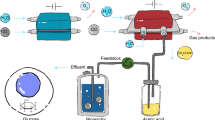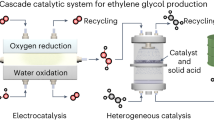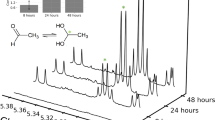Abstract
THE carbon sources in the growth media have been shown to affect the ethylene production by Penicillium digitatum. Fergus1 found mannose, mannitol, or citric acid as carbon sources resulted in good ethylene yields. Phan-Chon-Tôn2 found glucose supported high ethylene production. Pyruvate also served as a carbon substrate for cultures capable of producing ethylene. While Spalding and Lieberman3 reported 0.1 M glucose superior to 0.1 M concentrations of pyruvate, malate, or citrate for ethylene synthesis, I reported4 0.119 M L-malic acid and 0.119 M potassium pyruvate superior to other carbon sources tested for ethylene production. In contrast to the previously described short-term experiments, time-course investigations lasting several days were performed. As shown below, commonly metabolized organic acids at 0.119 M were superior to glucose or mannitol, at the same molarity, in ethylene synthesis.
This is a preview of subscription content, access via your institution
Access options
Subscribe to this journal
Receive 51 print issues and online access
$199.00 per year
only $3.90 per issue
Buy this article
- Purchase on SpringerLink
- Instant access to full article PDF
Prices may be subject to local taxes which are calculated during checkout
Similar content being viewed by others
References
Fergus, C. L., Mycologia, 46, 543 (1954).
Phan-Chon-Tôn, M., C.R. Acad. Sci., Paris, 244, 1243 (1957).
Spalding, D. H., and Lieberman, M., Plant Physiol., 38, 58 (1963).
Gibson, M. S., and Crane, F. L., Plant Physiol., 37, 18 (1962).
Pratt, H. K., doctoral dissertation, Univ. Col., Los Angeles (1944).
Young, R. E., and Biale, J. B., Plant Physiol., 37, 409 (1962).
Author information
Authors and Affiliations
Rights and permissions
About this article
Cite this article
GIBSON, M. Organic Acids as Sources of Carbon for Ethylene Production. Nature 202, 902–903 (1964). https://doi.org/10.1038/202902b0
Issue date:
DOI: https://doi.org/10.1038/202902b0



